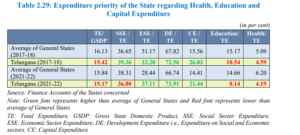The CAG noted that the higher the ratio of Education and Health components to total expenditure, the better the quality of expenditure.
Published Feb 27, 2024 | 11:00 AM ⚊ Updated Feb 27, 2024 | 11:00 AM

The report was filed by the Comptroller and Auditor General of India (CAG). (Sourced)
Telangana state finds itself consistently lagging behind in the realm of expenditure on Education and Health sectors, as revealed by the latest report from the Comptroller and Auditor General (CAG).
The CAG underscores that elevating human development levels necessitates a substantial increase in the state’s investment in pivotal social services such as Education and Health. The higher the ratio of these components to the Total Expenditure, the better the quality of expenditure.
According to the CAG report, in the fiscal year 2021-22, the average allocation by states to Education and Health comprised 14.66 percent and 6.20 percent of the total expenditure, respectively. However, Telangana diverged from this norm by earmarking a mere 8.14 percent for Education and 4.19 percent for Health within its total expenditure during the same period.

Telangana’s allocation to Education and Health. (CAG report)
“As a percentage to the total expenditure, expenditure on Education and Health was eight percent and four percent, respectively. The state has been persistently trailing in respect of expenditure on Education (by 6 percent) and Health (by 2 percent) during 2021-22, when compared to the other general states,” the CAG report stated.
Furthermore, the CAG report brings to light a widening gap in expenditure between Education and Health over the years. In 2017-18, while general states allocated an average of 15.17 percent to Education, Telangana allocated 10.54 percent of its total expenditure. Similarly, in the Health sector, while general states spent an average of 5.09 percent, Telangana allocated a slightly lower 4.59 percent.
The CAG report also notes a persistent trend in the government granting loans amounting to ₹360 crore to the Aarogyasri Health Care Trust (AHCT) in the fiscal year 2021-22, despite the absence of a clear and dedicated revenue source for the Trust to meet its loan repayment obligations.
The CAG report underscores the provision of loans totaling ₹2,866 crore to entities like the Aarogyasri Health Care Trust and TS Vaidya Vidhan Parishad, lacking a reliable and assured revenue stream for loan repayment.
The crux of the CAG report illuminates a stark reality — the Telangana government, spanning the years 2014-15 to 2021-22, failed to regularise a staggering excess expenditure totaling ₹2,89,115.29 crore.
In 2014-15, the excess expenditure stood at ₹303.65 crore, a figure that swelled to ₹5,880.79 crore in 2015-16 and further escalated to ₹21,161.59 crore in 2016-17. The upward trajectory continued with ₹28,171.27 crore in 2017-18, ₹29,133.69 crore in 2018-19, and a whopping ₹47,896.44 crore in the fiscal year 2019-20.
The pinnacle of this financial recklessness was reached in 2020-21, with excess expenditure soaring to ₹81,514.54 crore, and in 2021-22, the figure remained astronomical at ₹75,053 crore. Remarkably, none of these amounts underwent regularisation by the Legislative Assembly.
The protocol dictates that excess expenditure should undergo regularisation after deliberations in the Public Accounts Committee (PAC) in the Legislature. Despite the Committee convening five times — in May 2018, twice in August 2021, and in February and March 2022 — to scrutinise 10 paragraphs related to State Finance Audit Reports, the issue of regularising expenditure beyond Legislative authorisation has yet to be addressed.
“The persistent excess expenditure over grants/appropriation approved by the State Legislature is in violation of Article 204 and 205 of the Constitution, which provide that no money shall be withdrawn from the consolidated fund except under appropriation made by law by the State Legislature. This vitiates the system of budgetary and financial control and encourages financial indiscipline in management of public resources,” the CAG report stated.
